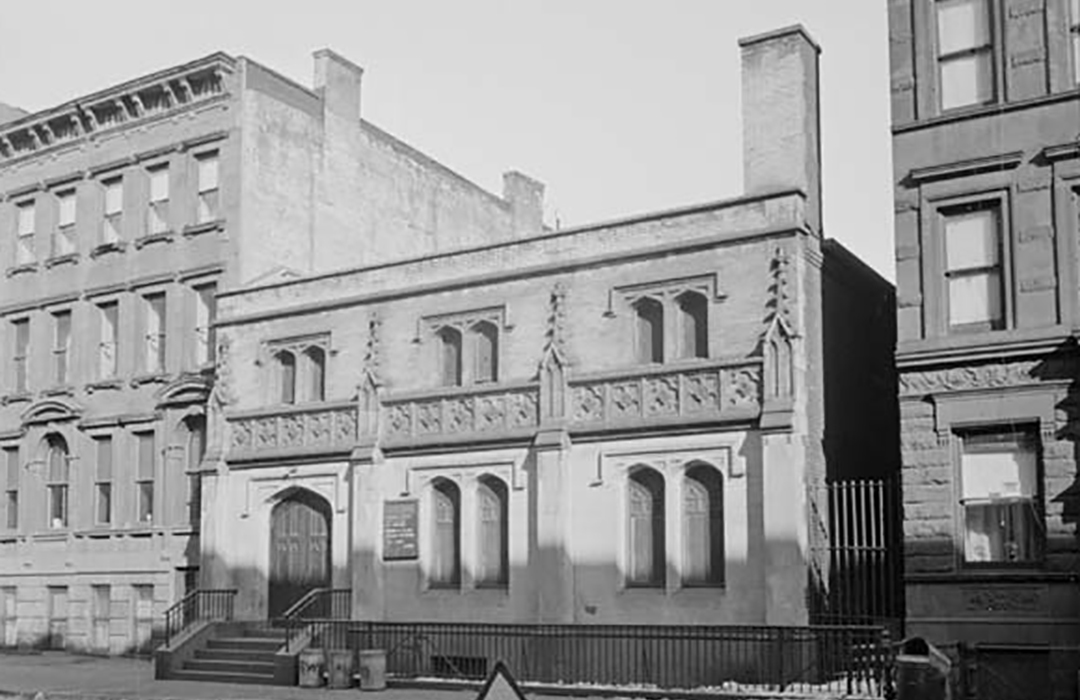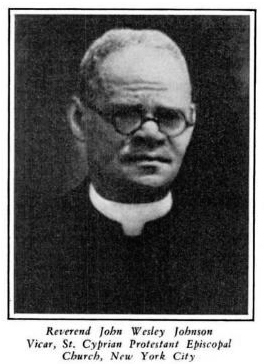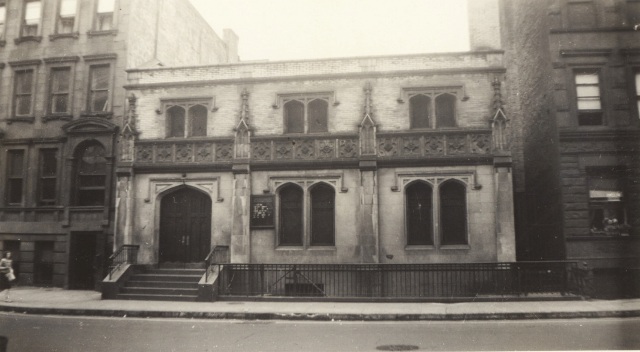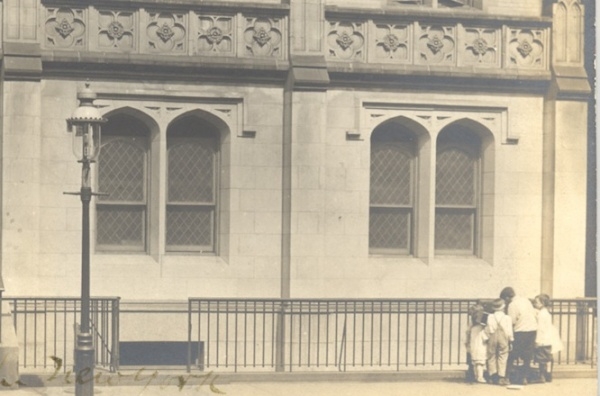
St. Cyprian’s and Reverend John Wesley Johnson
by Sarah Bean Apmann
As early as 1904, the New York City Mission Society initiated an effort in the San Juan Hill neighborhood towards creating a Protestant Episcopal parish to serve the Caribbean immigrants in the neighborhood (and thus keep them out of the white Episcopal churches). The result was the founding of St. Cyprian’s Church on West 63rd Street. Initially, the church occupied several row houses at 175-177 West 63rd Street that were constructed pre-1879, and this church became a very important fixture in the neighborhood. From its inception, St. Cyprians was led by Reverend John Wesley Johnson.
J. W. Johnson was born in Virginia on February 2, 1866. He was serving as a professor in the Divinity School* in 1905 when the Mission Society called on Johnson to start St. Cyprians. He was with the Society and the church for twenty-five years until his death in 1930. He also served as chaplain at Lincoln Hospital, an institution in the Bronx founded in 1839 for aged African Americans. His work and that of St. Cyprians not only proved invaluable to the African American community in San Juan Hill but also for the New York City African American population at large. In spite of leading this church which was formed to serve the black community, he was an outspoken critic of segregating races in their worship.
In April of 1906, while St. Cyprians was making plans to expand its physical space, the relatively new parish held its first public confirmation service at St. Stephens Church on West 69th Street for 52 candidates. In July of 1906, The New York Age, a prominent African American newspaper that was founded in 1887, reported that St. Cyprians had recently been renovated “to meet the demands of a larger and growing congregation.”
Initially, the church occupied several row houses at 175-177 West 63rd Street that were constructed pre-1879, and this church became a very important fixture in the neighborhood.
In the spring of 1907, a new building permit was filed for construction of a parish house at 169-171 West 63rd Street by the Protestant Mission Episcopal Society at 38 Bleecker Street. The brick and stone building would be one story in height, forty-one feet wide and ninety-five feet in depth, and cost $30,000. The architecture firm assigned to this task was Hoppin, Koen & Huntington at 244 Fifth Avenue. The firm was responsible for a number of noteworthy buildings throughout New York City including the Former Police Headquarters Buildings at 240 Centre Street in Manhattan, a New York City Landmark.
The church served the black community in a number of ways. Its community house featured a gymnasium where many early black boxer fighters trained. The Parish House was a social center for the community, Episcopalian and non-Episcopalian alike. Dances were held twice a week and were immensely popular and the Parish House maintained a playground for black children in the area. There were industrial, cooking and sewing schools as well as a laundry, an employment bureau, soup kitchen and home for immigrant girls. It also offered a milk station to parents of children in the area. Additionally, according to the New York Times, the YWCA for African Americans was organized at St. Cyprians. St. Cyprians and Rev. Johnson maintained close ties with local Caribbean groups including the West Indian Benevolent Association and the Bermuda Benevolent Association.
In 1907 Reverend J.W. Johnson publicly admonished Reverend Dr. George R. Van De Water of St. Andrew’s Episcopal Church at Fifth Avenue and 127th Street for siding with parishioners of that church who felt that African American parishioners should worship by themselves. Rev. Johnson was clear to point out that Rev. Dr. Van De Water had recently attended a luncheon at The NY Protestant Society City Mission Society attended by African Americans. This report in the New York Times was followed by an editorial which stated, “It certainly does not seem Christlike, either on the rector’s part or on the presumably Christian gentlemen which act as ushers.”
In 1908, The New York Age had this to report:
At Grace Church, Broadway and 10th streets, there took place a most unusual but significant occurrence. The congregation, one of the wealthiest and most influential in the United States, made its annual offering for the support of work among colored people of the Protestant Episcopal Church. Contrary to all precedent, but in the spirit of sweet Christian unity and in recognition of the splendid work which the Rev. John W. Johnson has done on the upper west side the Rev. Dr. William R. Huntington, who in more ways than one has shown himself a true friend of the colored people, invited the Rev. Mr. Johnson to be the special preacher on this occasion.
1500 people were in attendance of what was referred to as a “most excellent sermon.” The article followed with news that the congregation of St. Cyprians expected to enter their new house of worship by Easter.
A special congregational meeting was held at the church on March 7, 1924. Here, Rev. Johnson announced the beginning of an endowment fund drive with the goal of $100,000 by May 1, 1925, to mark the twentieth anniversary of the founding of the parish. At the meeting, cash contributions were made by local and non-local residents alike including Norman Drakes, owner of a nearby grocery store, Peter Williams, owner of several taxi cabs, Solomon Johnson, an inspector at Ellis Island, and William A. Rodriguez, an undertaker at 225 134th Street. Bishop Herbert Shipman, who was in attendance representing the diocese of New York donated $20 in gold. It should be noted that the grocer, Mr. Drakes donated $50.
1500 people were in attendance of what was referred to as a “most excellent sermon.”
On May 20, 1930, the New York Times reported “Thousands Mourn Rev. Dr. J.W. Johnson.” It was further reported that both Black and White citizens mourned the passing of Rev. Johnson on May 19, 1930 at St. Cyprians. The New York Times went on to say that more than forty white and black pastors were in attendance. In addition to the several thousand African American attendees (most of them women, according to the New York Times), several hundred flower arrangements and wreaths were sent to the church in honor of Rev. Johnson. The coffin was covered in roses and Sweet Peas sent from St. Martins Church in Harlem where his son Rev. John H. Johnson was a minister and wreaths were sent by the Brotherhood of St. Andrew, St. Mary’s Guild, and St. Cyprian’s Benevolent Society. Rev. Dr. John Wesley Johnson was buried in Woodlawn Cemetery.
*This comes from Johnson’s obituary in the New York Times, May 18, 1930. The article did not specify anything other than “Divinity School.”
Bragg, George Freeman, Jr. History of the Afro-American Group of the Episcopal Church. Maryland: Church Advocate Press. 1922.
Dunlap, David W. From Abyssinian to Zion: A Guide for Manhattan’s Houses of Worship. Columbia University Press. 2004.
The New York Age (New York, NY)
October 26, 1905, p. 5.
July 19, 1906, p. 6.
February 20, 1908, p. 1
November 30, 1911, p. 2.
July 27, 1916. p.2.
March 15, 1924, p. 1.
January 4, 1930, p. 5.
“Criticise Dr. Van de Water.” New York Times. March 4, 1907: p. 18.
“Rev. Dr. J.W. Johnson, Missionary, Dies.” New York Times. May 18, 1930.
“Thousands Mourn Rev. Dr. J.W. Johnson.” New York Times. May 20, 1930.
New York City Landmarks Preservation Commission. Former Police Headquarters Building, 240 Centre Street, Borough of Manhattan. September 26, 1978, LP-0999. http://s-media.nyc.gov/agencies/lpc/lp/0999.pdf – accessed 06/11/2022.
NYC Municipal Archives
https://nycma.lunaimaging.com/luna/servlet/detail/NYCMA~5~5~240084~516108
https://nycma.lunaimaging.com/luna/servlet/detail/NYCMA~5~5~240083~516109
Real Estate Record and Builders Guide June 1, 1907, v. 79, no. 2046, p. 1095. https://rerecord.library.columbia.edu/document.php?vollist=1&vol=ldpd_7031148_039&page=ldpd_7031148_039_00001145 – accessed 06/11/2022
Watkins-Owens, Irma. Blood Relations: Caribbean Immigrants and the Harlem Community, 1900-1930. Indiana University Press: 1996.
Sarah Bean Apmann is an architectural historian and principal of Sarah Bean Apmann Consulting, Inc.





